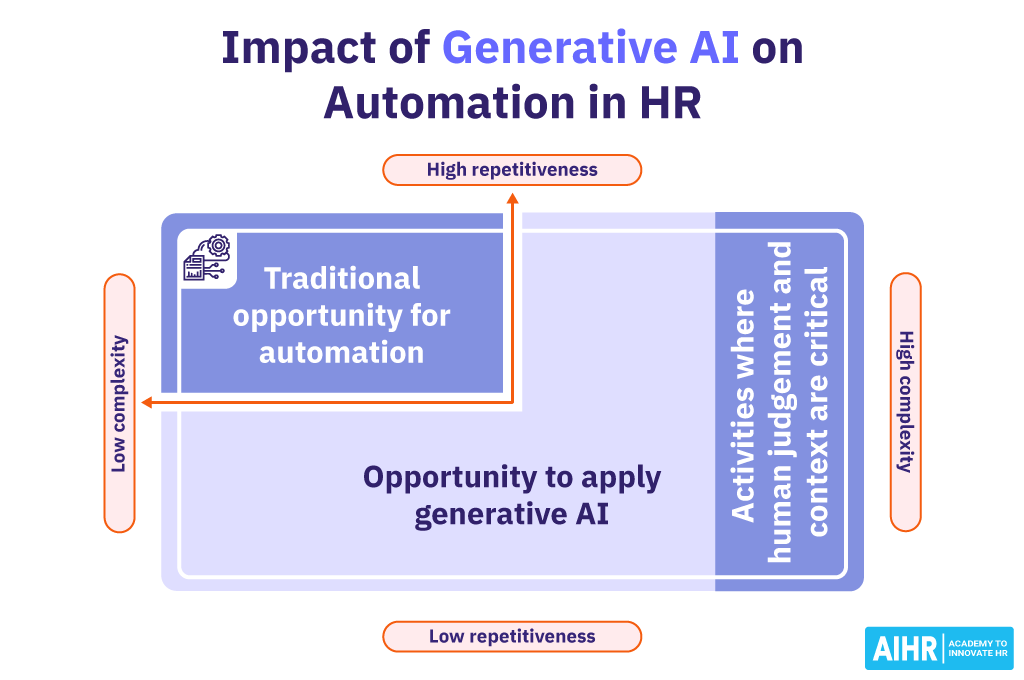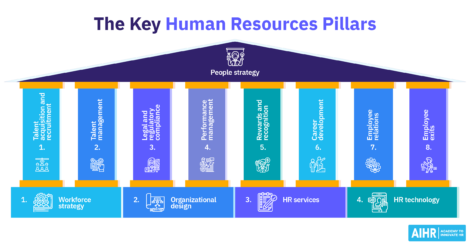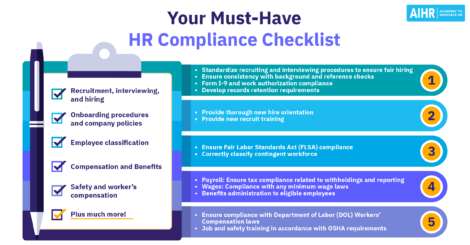HR Business Partnering: 5 Changes AI Will Bring

Generative artificial intelligence, including tools like ChatGPT, is creating new opportunities in Human Resources. It’s not just about increasing HR professionals’ productivity and improving HR solutions for the workforce. AI also has the potential to transform HR business partnering, pushing it towards a more strategic role.
In this article, we unpack five key ways that generative AI will change HR business partnering and how HR professionals can adapt to remain relevant in this changing world.
Contents
What is HR business partnering?
What is the future of HR business partnering?
5 ways AI will transform HR business partnering
What is HR business partnering?
HR business partnering refers to HR professionals working to align HR priorities with key business strategic objectives. They collaborate with senior leaders to understand how people practices can help deliver organizational goals.
Importantly, this definition describes business partnering as an approach, not the HR Business Partner as a job function.
The HR Business Partner role emerged as part of the strategic partner movement in the late 1990s. This role was associated with the Ulrich operating model. It positioned the HRBP as a strategic liaison between the business and the HR specialist areas, referred to as Centers of Excellence, and the shared administrative services. According to this definition, the HRBP is a role with key responsibilities and outcomes.
In contrast, HR business partnering as an approach goes beyond the scope of a role. It embodies an intentional strategy for how HR works with the business. It’s a specific mindset that we adopt to drive business value and a skillset of translating business needs into practical HR solutions.
“Business partnering is really understanding and being ingrained enough in the business that you are a true thought partner, you’re the right hand to your leadership team.”
Alexis Crimaldi, HRBP Lead, US Data Security at TikTok
To illustrate this, let’s look at a practical example of HR business partnering in action.
Nondeka is a learning specialist, currently working with her organization to develop a new sales curriculum. This initiative aims to help the business grow their new product line and meet the business targets. She meets with the business stakeholders, understands their needs, develops a program, and works with them to execute the learning.
In this example, Nondeka adopted a business partnering approach to find the optimal solution, even though her formal role was as a learning specialist. We can find similar examples across both specialist and generalist roles.
We firmly believe that all HR professionals will need to embrace a business partnering approach to remain relevant as AI starts to take over some key HR responsibilities. In other words, HR business partnering needs to move beyond only the designated HRBP role.
What is the future of HR business partnering?
Generative AI will enable true HR business partnering in the future. Even though HR automation has been removing administrative work from HR professionals, it’s still not equipped to tackle the more complex aspects of the job.
Eliminating administrative work is not just about automating processes. It’s also about using technology in a way that frees up more time for the workforce, allowing them to focus on creating new value.
So far, technology has largely focused on work with a high level of repetitiveness and low complexity. However, the challenge is that a lot of administrative process work in HR is not simple or repetitive.
Take the example of guiding an employee concerning the best options for a pension benefit. Even though this is a regular occurrence, context plays a crucial role in proposing the right solution. The life stage of the employee, their family structure, and the business culture and approach towards family benefits are all at play here.
While technology might not have been able to solve such challenges just yet, this is going to change with generative AI. The ability of generative AI to interpret large amounts of data and engage with individuals to find an optimal answer will finally allow true business partnering for all roles in HR.
For HR professionals, working with these new technologies will allow more focus on the high-complexity work that requires human judgment and context. If applied responsibly, generative AI could be the stepping stone to a new chapter in strategic HR value.
We discussed the future of HR business partnering with Alexis Crimaldi, HRBP Lead at TikTok. Find out more in the full interview below:
5 ways AI will transform HR business partnering
As generative AI is bringing inevitable changes to how HR professionals partner with the business, what do you need to prepare for to continue adding value to your organization?
Change 1: Generative AI will extend the reach of HR partnering to a broader employee audience
Today, business partnering focuses primarily on senior leaders and managers within the organization. Two arguments have traditionally driven this approach.
First, by focusing on leaders and managers, we can impact the broadest possible audience. “Helping managers also help their teams” is often used as the rationale for this approach. The second argument is resource constraints, with small HR teams deciding where to spend their limited time and capacity.
These arguments are not without merit. However, it has led to a reality where many employees’ HR experience is limited to hiring, firing, benefits, and payroll. With generative AI, we finally have an opportunity to extend our HR solutions to a broader audience.
Let’s make this practical.
Thando works in a manufacturing plant. He is one of the 450 employees at this site. The site has one permanent HR consultant responsible for end-to-end HR, with a specialist team at the head office that rarely visits the site.
Thando has questions about his career and what training courses he needs to enroll in to take that next step. He has spoken to his manager, who referred him to the intranet and HR. Unfortunately, Thando has not been able to find time in the HR consultant’s diary as he is fully booked and usually in meetings or interviews.
With generative AI, the HR team could implement a chatbot that provides Thando with career guidance and advice by understanding the available career paths in the organizations. Utilizing the data that Thando shares, this chatbot could offer structured advice and match the best possible learning opportunities with his ambitions and goals.
Equipped with this output, Thando’s conversation with his manager changes from “I want to develop” to something more concrete: “I want to enroll in these courses to develop into a specific role.”
By all means, generative AI has the opportunity to expand HR’s coverage and reach of HR solutions to drive a truly engaging employee experience.
Change 2: Generative AI will become part of the workforce that HR needs to manage
Today, when we think about the workforce, we usually refer to the permanent employees, gig workers, contractors, and vendors that do the work. In the future, the workforce will also consist of co-bots that work with individuals in both a professional and personal capacity to do the work.
Let’s have a look at an example.
Benny is a Benefits Administrator. He is Tier 3 query support for individuals related to the pension fund administration. He is the key liaison with the 3rd party vendor to implement the right solutions for their employees.
Tier 1 and Tier 2 support is provided by a bot nicknamed Nemo, who manages all employee queries related to existing pension plans. Benny also uses his own personal bot as a productivity tool that helps him with project planning, writing pension reports, and analyzing pension fund trends.
In this example, the workforce looks more like this:
What’s more, any vendors or third parties organizations work with will also bring their technology to the table.
Why is this important for HR? As generative AI becomes more advanced, it can take on full responsibility for specific tasks and activities. This will not only impact work design but also how we do capacity planning in the future. HR needs to understand exactly what value the AI bots bring to the workforce and how they should incorporate them into workforce plans for the future.
Change 3: AI will start managing work and people
We are already seeing algorithms manage large parts of work allocation today. For example, the Uber algorithm allocates potential rides to specific drivers based on past patterns and current utilization. As AI advances, we can expect more of this to happen as we use data to allocate and distribute work to manage workload fairly.
However, HR has to keep in mind that even though algorithms can be used to manage work and people, there is still a role for human managers and leaders.
Identifying the moments that matter in this relationship becomes essential. Even though AI can contribute crucial insights when discussing career advancement or other personal matters, these conversations still require a human touch.
Today, managers are responsible for managing both work and people. AI can play a crucial part in freeing managers to focus on true people management. The future could be an opportunity to make people managers accountable for managing the engagement and well-being of their team members.
Change 4: Changing the work content of HR when partnering with the business
As mentioned earlier in this article, AI can take away several activities from day-to-day HR work. While this is a positive movement, HR practitioners must acknowledge that their roles and jobs will look very different.
To adapt to these changes, we must deconstruct the activities within an HR job today and critically evaluate which activities AI can take over.
Similarly, we need to identify what must be done by humans and how removing certain activities from the current role opens up new opportunities and possibilities for the future.
For example, AI could take over answering policy questions, providing information about practices, and basic data analysis. This could free up more time for activities related to other areas of HR impact, such as employee experience design or stakeholder engagement.
Will certain HR roles no longer exist? Yes, there will be roles that are no longer required. At the same time, new roles will emerge due to the changes and opportunities that AI will bring.
Change 5: A new skills profile is required for HR business partnering
With the omnipresent technology, HR professionals will need a new skills profile to partner with the business effectively. They need to develop several core HR competencies to succeed.
First, business acumen remains a crucial competency for anyone working within HR. You must understand the business to effectively partner or align the appropriate HR solutions to business needs.
Second, a competency we refer to as “Delivering through technology” is becoming increasingly important. It relates to practitioners’ ability to utilize their knowledge and skills to implement and integrate technology into HR solutions to drive efficiency, scale, and business impact.
As generative AI becomes a key part of how we work, HR professionals must be able to integrate AI into their daily activities while also understanding how to work with AI technologies responsible for adjacent tasks.
Third, becoming data-driven and evidence-based is also imperative. This refers to the ability of HR practitioners to use data to test hypotheses, make better business decisions, and demonstrate business value.
Fourth, problem-solving skills will help HR professionals navigate the intricacies of the new reality, tackle complex issues and deal with contrasting situations by applying analytical and adapting approaches. Successful HR practitioners will be able to find new solutions within a digitally enabled workforce that will help their business win in the marketplace.
“Can you see the 50,000-foot view? Can you also see the 50-foot view? How are you being the glue between the two? That is our magic as HRBPs.
I know what this is going to take down here, here’s where we’re trying to go. How are you helping the leaders navigate through the noise?”
Alexis Crimaldi, HRBP Lead, US Data Security at TikTok
For HR professionals to be true business partners working with generative AI, these skills will become necessary for the future.
Final words
HR professionals in all kinds of roles need to adopt the HR business partnering approach and mindset to succeed in the age of generative AI. This technology will become a key part of the workforce that the HR professional needs to manage while also changing the daily tasks and activities for which the HR professional is responsible.
These changes will provide new opportunities for HR to contribute strategic value to the business while reaching more people with value-adding HR solutions.
Weekly update
Stay up-to-date with the latest news, trends, and resources in HR
Learn more
Related articles
Are you ready for the future of HR?
Learn modern and relevant HR skills, online















